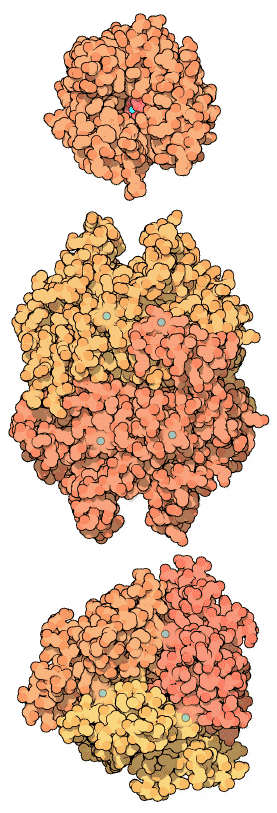|
Inhaltsübersicht | Nanomaschinen | Moleküle | Programme | Kurse | Fun | Links |
||
| > |
Carbonic Anhydrase

Breathing In, Breathing Out
Breathing is a fundamental function in life - ever wondered what really happens when we breathe? The air we breathe in has precious oxygen that fuels the breakdown of sugars and fat in our cells. In our lungs, oxygen diffuses into the blood, binds to hemoglobin and is transported to all the cells of our body (see the Molecule of the Month feature on hemoglobin). Carbon dioxide is a byproduct of sugar and fat breakdown in cells and needs to be removed from our body. Again, blood acts as a transport medium. Carbon dioxide diffuses out of cells and is transported in blood in a few different ways - less than 10% dissolves in the blood plasma, about 20% binds to hemoglobin, while the majority of it (70%) is converted to carbonic acid to be carried to the lungs. An enzyme present in red blood cells, carbonic anhydrase, aids in the conversion of carbon dioxide to carbonic acid and bicarbonate ions. When red blood cells reach the lungs, the same enzyme helps to convert the bicarbonate ions back to carbon dioxide, which we breathe out. Although these reactions can occur even without the enzyme, carbonic anhydrase can increase the rate of these conversions up to a million fold.Green Plants and Corals
Plants also use oxygen for producing energy, and also release carbon dioxide. Green plants can convert water and carbon dioxide into sugars in the presence of sunlight. This process, photosynthesis, uses carbon dioxide from the atmosphere. Gaseous carbon dioxide is stored in plants as bicarbonate ions. In both land and water plants, carbonic anhydrase plays a role in converting bicarbonate ions back to carbon dioxide for photosynthesis. Another interesting biological phenomenon where this enzyme plays a role is the calcification of corals. Seawater calcium reacts with the bicarbonate produced by carbonic anhydrase from the coral polyps, forming calcium carbonate. This is deposited as the hard exterior of corals.Carbonic Anhydrases
Carbonic anhydrase is an enzyme that assists rapid inter-conversion of carbon dioxide and water into carbonic acid, protons and bicarbonate ions. This enzyme was first identified in 1933, in red blood cells of cows. Since then, it has been found to be abundant in all mammalian tissues, plants, algae and bacteria. This ancient enzyme has three distinct classes (called alpha, beta and gamma carbonic anhydrase). Members of these different classes share very little sequence or structural similarity, yet they all perform the same function and require a zinc ion at the active site. Carbonic anhydrase from mammals belong to the alpha class, the plant enzymes belong to the beta class, while the enzyme from methane-producing bacteria that grow in hot springs forms the gamma class. Thus it is apparent that these enzyme classes have evolved independently to create a similar enzyme active site. PDB entries 1ca2, 1ddz and 1thj, shown here from top to bottom, are examples of the alpha, beta and gamma carbonic anhydrase enzymes, respectively. The zinc ions in the active site are colored blue in these figures. Note that the alpha enzyme is a monomer, while the gamma enzyme is trimeric. Although the beta enzyme shown here is a dimer, there are four zinc ions bound to the structure indicating four possible enzyme active sites. Other members of this class form tetramers, hexamers or octamers, suggesting that dimer is probably a building block for this class.Mammalian carbonic anhydrases occur in about 10 slightly different forms depending upon the tissue or cellular compartment they are located in. These isozymes have some sequence variations leading to specific differences in their activity. Thus isozymes found in some muscle fibers have low enzyme activity compared to that secreted by salivary glands. While most carbonic anhydrase isozymes are soluble and secreted, some are bound to the membranes of specific epithelial cells. For a deeper look at carbonic anhydrase from a genomic perspective, please visit the Protein of the Month feature at the European Bioinformatics Institute.
Last changed by: A.Honegger,